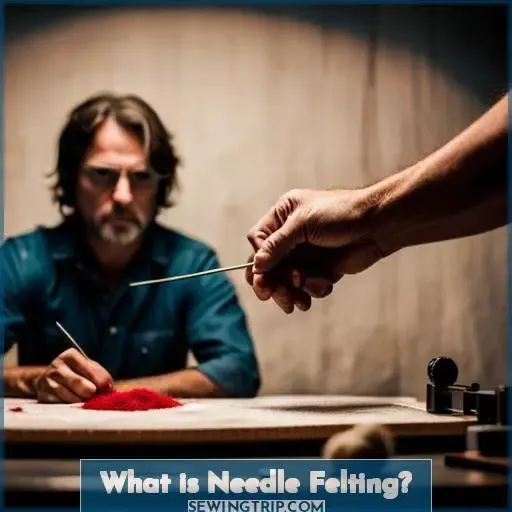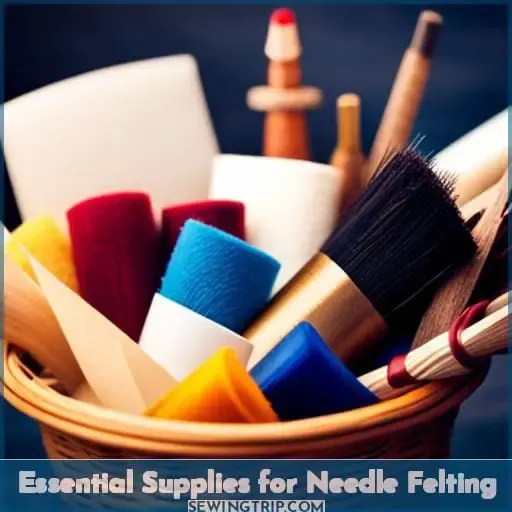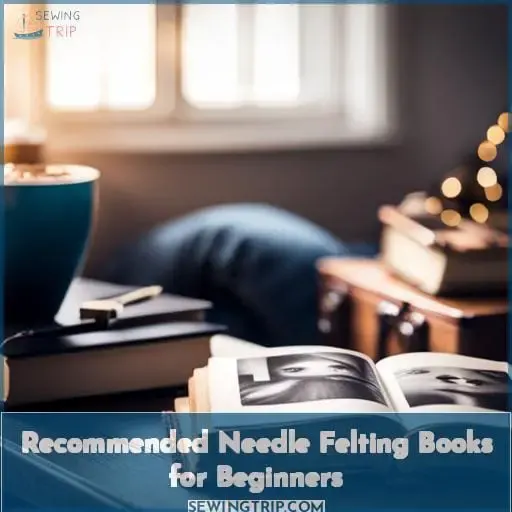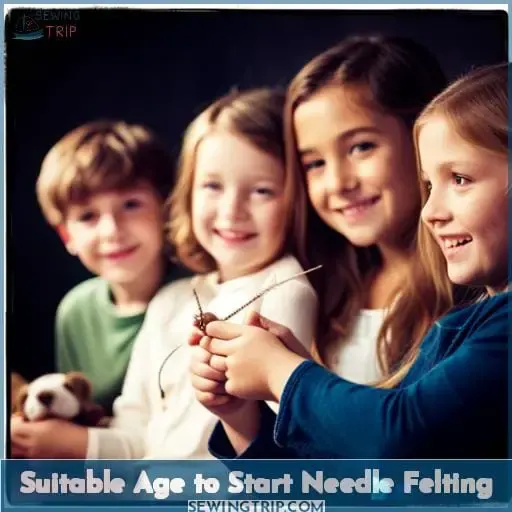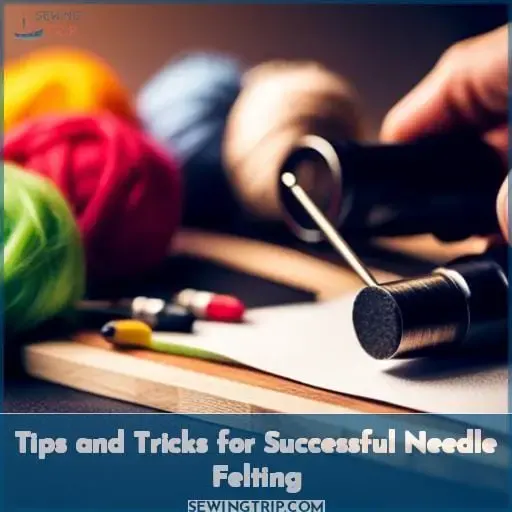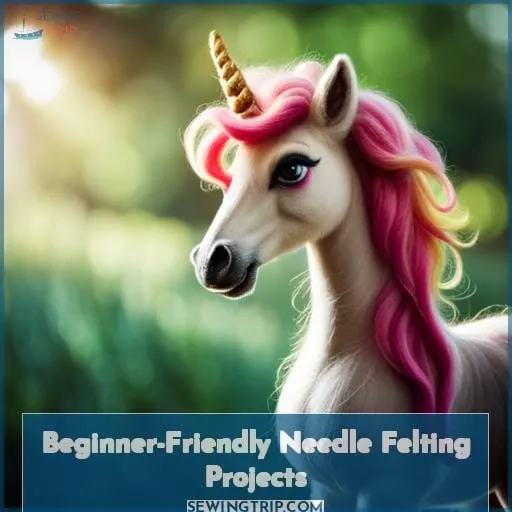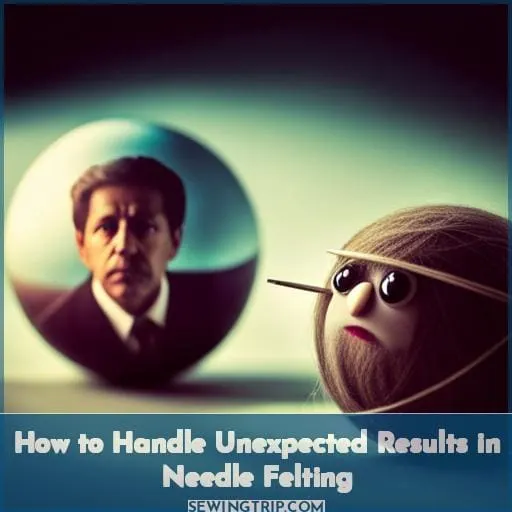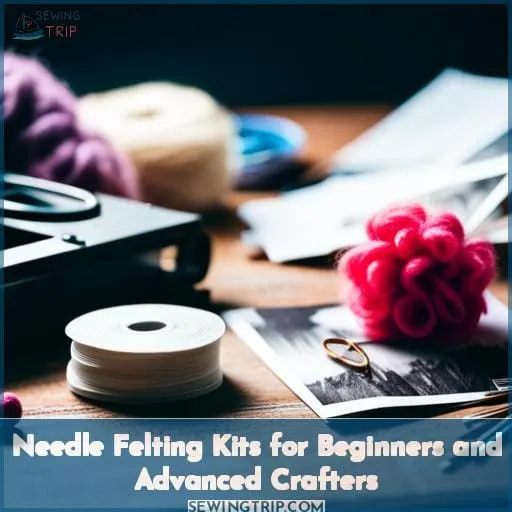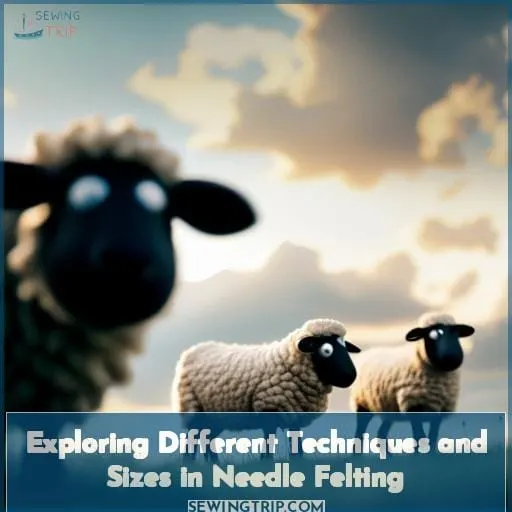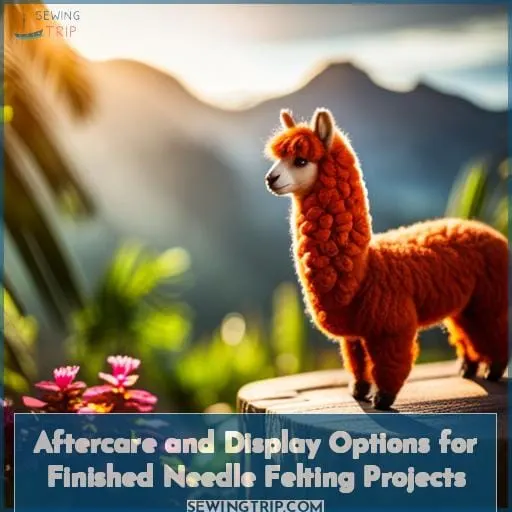This site is supported by our readers. We may earn a commission, at no cost to you, if you purchase through links.
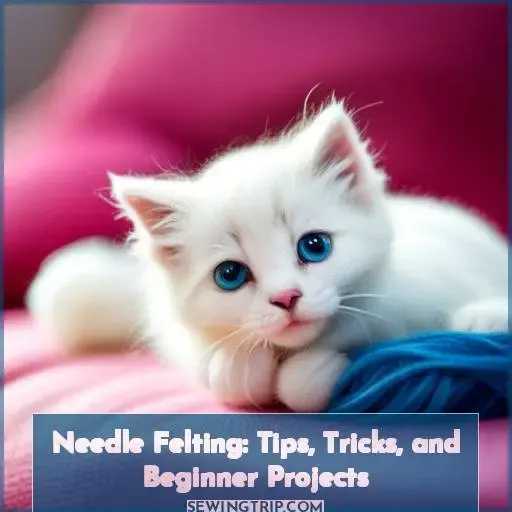 Get ready to dive into the world of needle felting! In this article, we’ll explore tips, tricks, and beginner projects that will help you master this creative craft.
Get ready to dive into the world of needle felting! In this article, we’ll explore tips, tricks, and beginner projects that will help you master this creative craft.
With just a few supplies and some wool roving, you’ll be able to sculpt amazing shapes and figures using special felting needles. Whether you’re a seasoned textile artist or new to the craft scene, needle felting offers endless possibilities for creating unique creations.
So let’s get started on your journey towards mastery in needle felting!
Table Of Contents
- Key Takeaways
- What is Needle Felting?
- Essential Supplies for Needle Felting
- Recommended Needle Felting Books for Beginners
- Suitable Age to Start Needle Felting
- Tips and Tricks for Successful Needle Felting
- Beginner-Friendly Needle Felting Projects
- How to Handle Unexpected Results in Needle Felting
- Needle Felting Kits for Beginners and Advanced Crafters
- Exploring Different Techniques and Sizes in Needle Felting
- Aftercare and Display Options for Finished Needle Felting Projects
- Frequently Asked Questions (FAQs)
- Conclusion
Key Takeaways
- Wool roving, felting needles, and a felting mat are the essential materials needed for needle felting.
- Needle felting is generally recommended for children aged 8 and older and should be supervised by an adult for younger children.
- Beginners should avoid using sharp needles, felt tighter for firmness, and practice patience and embrace mistakes.
- Needle felting can be used to create small felted animals, 3D figures, embellish clothing or accessories, and create unique jewelry pieces.
What is Needle Felting?
Needle felting is the art of sculpting wool using specialized needles with notches. It involves repeatedly poking these needles into wool roving to condense the fibers into a desired form.
This technique allows for creative inspiration and endless possibilities in creating unique sculptures, accessories, and decorations.
When engaging in needle felting, it’s important to consider safety precautions such as keeping fingers away from sharp needles and using finger guards when needed.
Choosing the right type of needle for your project is also crucial in achieving desired results.
From basic shapes like body parts to intricate figures and designs, there are plenty of project ideas to explore in needle felting.
With its versatility and minimal supplies required, this craft offers an opportunity for beginners to dive into basic needle felting techniques while allowing experienced artists to further refine their sculpting skills.
[ADDITIONAL INFORMATION]:
- Needle Felting: Tips & Tricks
- Beginner’s Guide: Getting Started with Needle Felting
- Basic Techniques for Successful Needle Feltings
Essential Supplies for Needle Felting
When it comes to needle felting, there are a few essential supplies that you’ll need to get started.
First and foremost is wool roving, the primary material used in needle felting.
You’ll also need felting needles, which have tiny barbs that help tangle the wool fibers together.
And don’t forget a felting mat or cushion to provide a dedicated work surface and absorb the impact of your needle.
Optional tools like finger guards and needle holders can also be helpful for protecting your hands during the process.
Wool Roving
When starting your needle felting journey, one of the essential supplies you’ll need is wool roving.
Choose from a variety of colors and textures for your projects.
Blend colors to create unique shades and explore different felting techniques on a felting mat or cushion.
Felting Needles
Now let’s delve into the essential supplies for needle felting by exploring the role of felting needles in this addictive craft.
- Felting Needle Selection
- Needle Felting Safety
- Needle Felting Techniques
- Needle Felting Tips
- Needle Felting Projects
Felting Mat or Cushion
To create a comfortable and effective work surface, you’ll need a felting cushion or mat for your needle felting projects.
Consider the size, durability, and anti-slip properties of the mat to ensure it suits beginners and is travel-friendly.
Optional Tools (Finger Guards, Needle Holders)
Protect your fingers and enhance your felting experience with optional tools such as:
- Finger guards
- Needle holders
- Bamboo tongs
These tools not only prevent injuries but also provide better control while working with delicate materials.
Recommended Needle Felting Books for Beginners
If you’re a beginner looking to dive into the world of needle felting, there are several recommended books that can provide valuable guidance and inspiration.
Needle felting books offer step-by-step instructions, tips and tricks for needle felting, and beginning projects to get you started on your creative journey.
Some popular choices include Needle Felting for Beginners and My First Needle Felting Book.
These beginner-friendly books cover the basics of needle felting techniques, safety precautions, different types of wool roving (such as coarse or fine), various sizes of felting needles (like 36 or 38 gauge), and the importance of using a proper cushion or mat while working.
Whether you want to create cute animals or intricate designs with wool fibers, these needle felting books will provide helpful insights into this addictive craft.
Suitable Age to Start Needle Felting
If you have a budding artist in your household, you may be wondering what age is suitable for them to start needle felting. While there isn’t an exact age requirement, it’s generally recommended that children aged 8 and older can safely engage in this craft with proper supervision.
Needle felting involves using sharp needles to sculpt wool into various shapes and figures, so adult guidance is essential to ensure safety.
To get young beginners started on their needle felting journey, consider simple projects like creating a wool felt garland or crafting basic animal shapes. These beginner-friendly projects allow children to practice the art of sculpting with wool while developing their motor skills and creativity.
Additionally, there are needle felting kits available specifically designed for beginners that provide step-by-step instructions and all the necessary materials. These kits make learning easier by providing everything needed for successful projects right out of the box.
Remember to always supervise younger children during needle felting activities to prevent accidents or injuries from occurring. With the appropriate guidance and suitable beginner projects at hand, kids can discover their passion for this unique form of artistic expression at an early age.
Tips and Tricks for Successful Needle Felting
To ensure successful needle felting, it’s important to keep in mind a few tips and tricks that will help you achieve the desired results:
- Avoid using sharp needles: It’s crucial to use felting needles with barbs, but be cautious to avoid accidental pokes.
- Felting tighter for firmness: The key is to repeatedly stab the wool with your needle until it becomes compact and firm.
- Practice patience and embrace mistakes: Needle felting is a learning process. Don’t be discouraged by mistakes; they can lead to creative exploration.
By following these tips, you’ll be on your way to creating intricate 3D body parts and shaping wool into beautiful creations. Remember that practice makes perfect, so don’t hesitate to start small as you embark on this artistic journey of needle felting.
Beginner-Friendly Needle Felting Projects
Now let’s explore some beginner-friendly needle felting projects that will help you practice your skills and create adorable crafts.
For those just starting out, small felted animals are an easy and fun project to begin with. You can use basic shapes like spheres for the body and triangles for the ears to create cute little creatures.
To bring them to life, all you need is wool roving in different colors, felting needles, a felting mat or cushion, and optional finger guards for safety.
Creating 3D figures requires patience and practice in needle felting techniques. Start by sculpting simple shapes like balls or cylinders as a foundation before adding details like facial features or fur texture using smaller needles.
Remember to always prioritize safety when working with sharp needles; keep your fingers away from them at all times! And don’t be discouraged by mistakes – they’re part of the creative exploration process in needle felting.
Embrace imperfections as opportunities for learning and growth on your journey towards mastery.
How to Handle Unexpected Results in Needle Felting
When faced with unexpected results in your needle felting projects, don’t get discouraged. Instead, embrace the opportunity to learn and adapt your techniques for future creations.
Here are some tips on how to handle those unexpected outcomes:
- Embrace imperfections: Remember that every needle felter encounters setbacks and mistakes along the way. Imperfections can add character and uniqueness to your finished project.
- Take a break: If you’re feeling frustrated or stuck, step away from your work for a while. Sometimes, taking a break and coming back with fresh eyes can give you new ideas or perspectives.
- Every Needle Felter accumulates limbs in limbo – keep them around! Those extra parts may come in handy for future projects as embellishments or additions.
- Practice makes perfect: Needle felting is a skill that improves over time with practice. So keep honing your skills through consistent practice sessions.
Needle Felting Kits for Beginners and Advanced Crafters
- If you’re a beginner or an advanced crafter looking to dive into the world of needle felting, there are a variety of needle felting kits available to help you get started on your creative journey.
These kits come in different types, sizes, and price ranges to suit your needs and preferences. Whether you’re looking for the best beginner kit or an affordable option that includes all the essentials, there’s something out there for everyone.
When choosing a needle felting kit, consider whether you want a large kit with multiple colors and tools or a small kit that focuses on specific projects. Some kits may include extra materials like foam blocks for sculpting shapes or safety accessories like finger guards.
Table: Needle Felting Kits Comparison
| Kit Name | Type | Size | Price Range |
|---|
Exploring Different Techniques and Sizes in Needle Felting
As you continue your needle felting journey, it’s time to explore the endless possibilities of different techniques and sizes in this creative craft.
- Experiment with Different Needle Felting Tools:
- Explore the variety of felting needles available, such as triangular, star, spiral, or crown-shaped needles. Each type offers unique effects and can help create different textures in your projects.
- Mastering Various Needle Felting Techniques:
- Learn and practice a range of techniques like sculpting shapes using basic stabbing motions or adding intricate details by layering wool roving. Enhancing your skills will allow for more complex designs and bring depth to your creations.
- Scaling Up or Down:
- Don’t limit yourself to one size when working on 3D needle felting projects. Try creating both large-scale sculptures that make a bold statement as well as miniature pieces packed with intricate details.
By embracing these tips and exploring new approaches in technique and size selection, you’ll be able to push the boundaries of what can be achieved through needle felting while honing your craftsmanship along the way.
Aftercare and Display Options for Finished Needle Felting Projects
Now that you have explored different techniques and sizes in needle felting, it’s important to consider the aftercare and display options for your finished projects. After putting in all that time and effort into creating a beautiful piece of needle felted art, you want to ensure its longevity.
To keep your needle felting projects looking their best, there are a few key guidelines to follow.
First, avoid exposing them to harsh chemicals or direct sunlight as they can cause fading or damage over time.
Additionally, it’s important to store your creations in a cool, dry place away from moisture that could lead to mold or mildew growth.
When it comes time for cleaning and dusting your finished pieces, use caution. Avoid using water on wool-based items as this can cause shrinkage or distortion.
By following these simple care instructions – avoiding harsh chemicals and direct sunlight while storing in a cool dry place – you’ll be able enjoy the beauty of your felted creations for years come!
Frequently Asked Questions (FAQs)
Can I use any type of wool for needle felting?
Yes, you can use various types of wool for needle felting.
Coarse and fine wool rovings are commonly used, with different colors and textures available.
Experimenting with different wools adds depth and character to your needle felted creations.
How do I choose the right size and shape of felting needles?
To choose the right size and shape of felting needles, consider your project’s needs.
For detailed work, use a fine gauge needle like a 38 or 40 triangle-shaped needle.
For larger areas, opt for a coarser gauge like a 36 star-shaped needle for faster felting.
What are some common mistakes to avoid when needle felting?
Avoid common mistakes in needle felting by ensuring you use the right size and shape of felting needles.
Don’t rush the process; take your time and be patient.
Pay attention to detail, as precision is key to achieving desired results.
Can I mix different colors of wool roving together?
Yes, you can mix different colors of wool roving together in your needle felting projects. This allows for endless possibilities and the creation of unique shades and blends to bring your creative vision to life.
What are some alternative uses for needle felting besides creating sculptures and figures?
Expand your needle felting horizons by exploring alternative uses beyond sculptures and figures.
Try creating unique jewelry pieces,
embellish clothing or accessories,
decorating home decor items,
or even designing custom greeting cards with needle felting techniques.
Let your creativity soar!
Conclusion
In your journey towards mastering needle felting, you have learned about the essential supplies, tips and tricks, and beginner-friendly projects.
Needle felting offers endless possibilities for creating unique creations with just a few supplies and some wool roving.
Whether you’re a seasoned textile artist or new to the craft scene, needle felting allows you to sculpt amazing shapes and figures using special felting needles.
So why wait? Dive into the world of needle felting and let your creativity soar!

